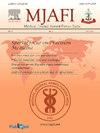比较微型 PCNL 和标准 PCNL 治疗 1-2 厘米大小的下盏肾结石的随机对照试验
Q2 Medicine
引用次数: 0
摘要
下盏解剖结构使得结石清除在所有治疗形式中都是一项困难的任务。光学技术的进步和仪器的小型化为经皮肾镜取石术(PCNL)提供了一种更有效、更安全的选择。这项研究是为了比较迷你pcnl和标准pcnl的疗效和并发症。方法采用随机对照试验,比较迷你pcnl与标准pcnl治疗1 ~ 2 cm下盏结石的疗效。目的是比较围手术期出血、手术时间、术后镇痛需求、住院时间和1个月无结石率。下盏结石1 ~ 2 cm的患者纳入研究。排除病态肥胖个体、肾脏畸形患者和儿童年龄组。结果同期行PCNL患者207例,共纳入157例。迷你pcnl 80例,标准pcnl 77例。Mini-PCNL在住院时间(3.96 vs 4.73天)、术后镇痛需求(2.58 vs 5.55克)和Hb下降(0.59 vs 0.81克/分升)方面得分高于标准。mini-PCNL的结石清除率较好(87.01% vs 93.75%)。标准pcnl的平均手术时间稍好(44.03 vs 43.33分钟)。两组结石清除率和平均手术时间比较,差异无统计学意义。mini-PCNL的镇痛需求在统计学上较低,这是由于更小的管道和无管pcnl。由于术后疼痛较轻,迷你pcnl患者住院时间较短。由于径道扩张较小和小束出血,mini-PCNL患者围术期出血在统计学上较低。结论mini - pcnl是治疗1-2 cm下盏结石的安全有效的治疗方法,与标准pcnl相比,出血少,住院时间短,镇痛需求少,结石清除率相当。本文章由计算机程序翻译,如有差异,请以英文原文为准。
Randomized control trial to compare mini-PCNL vs standard-PCNL for treatment of 1–2 cm size inferior calyceal renal stone
Background
Lower calyceal anatomy makes the stone clearance a difficult task across all treatment formats. Improvement in optics and miniaturization of instruments have offered an effective and safer alternative to percutaneous nephrolithotomy (PCNL). The study was conducted to compare the efficacy and complications associated with mini-PCNL vs standard-PCNL.
Methods
The study was a randomized control trial to compare mini-PCNL vs standard-PCNL for treatment of 1 to 2 cm inferior calyceal stones. Objectives were to compare peri-operative bleeding, operative-time, post-op analgesia requirement, hospital-stay and stone-free rate at 1 month. Patients with 1–2 cm inferior calyceal stones were included. Morbidly obese individuals, patients with renal malformation and paediatric age group were excluded.
Result
One hundred and fifty seven patients were included out of 207 who underwent PCNL in this period. 80 underwent mini-PCNL and 77 standard-PCNL. Mini-PCNL scored over standard in hospital-stay (3.96 vs 4.73 days), post-operative analgesia requirement (2.58 vs 5.55 gms) and drop in Hb (0.59 vs 0.81 gm/dl). Even stone clearance rate was better for mini-PCNL (87.01% vs 93.75%). Mean surgery time was marginally better for standard-PCNL (44.03 vs 43.33 mins). Stone clearance rate and average surgery time were comparable with no statistically significant difference in the two groups. Analgesia requirement was statistically lower in mini-PCNL due to smaller tract and tubeless-PCNL. Hospital stay was statistically lower in mini-PCNL due to lesser post-operative pain. Peri-operative bleeding was statistically lower in mini-PCNL due to smaller track dilatation and lesser tract bleeding.
Conclusions
Mini-PCNL is a safe and effective treatment option in the management of 1–2 cm inferior calyceal stones with significantly less bleeding, shorter hospital-stay and analgesia requirement as compared to standard-PCNL with comparable stone clearance rates.
求助全文
通过发布文献求助,成功后即可免费获取论文全文。
去求助
来源期刊

Medical Journal Armed Forces India
Medicine-Medicine (all)
CiteScore
3.40
自引率
0.00%
发文量
206
期刊介绍:
This journal was conceived in 1945 as the Journal of Indian Army Medical Corps. Col DR Thapar was the first Editor who published it on behalf of Lt. Gen Gordon Wilson, the then Director of Medical Services in India. Over the years the journal has achieved various milestones. Presently it is published in Vancouver style, printed on offset, and has a distribution exceeding 5000 per issue. It is published in January, April, July and October each year.
 求助内容:
求助内容: 应助结果提醒方式:
应助结果提醒方式:


